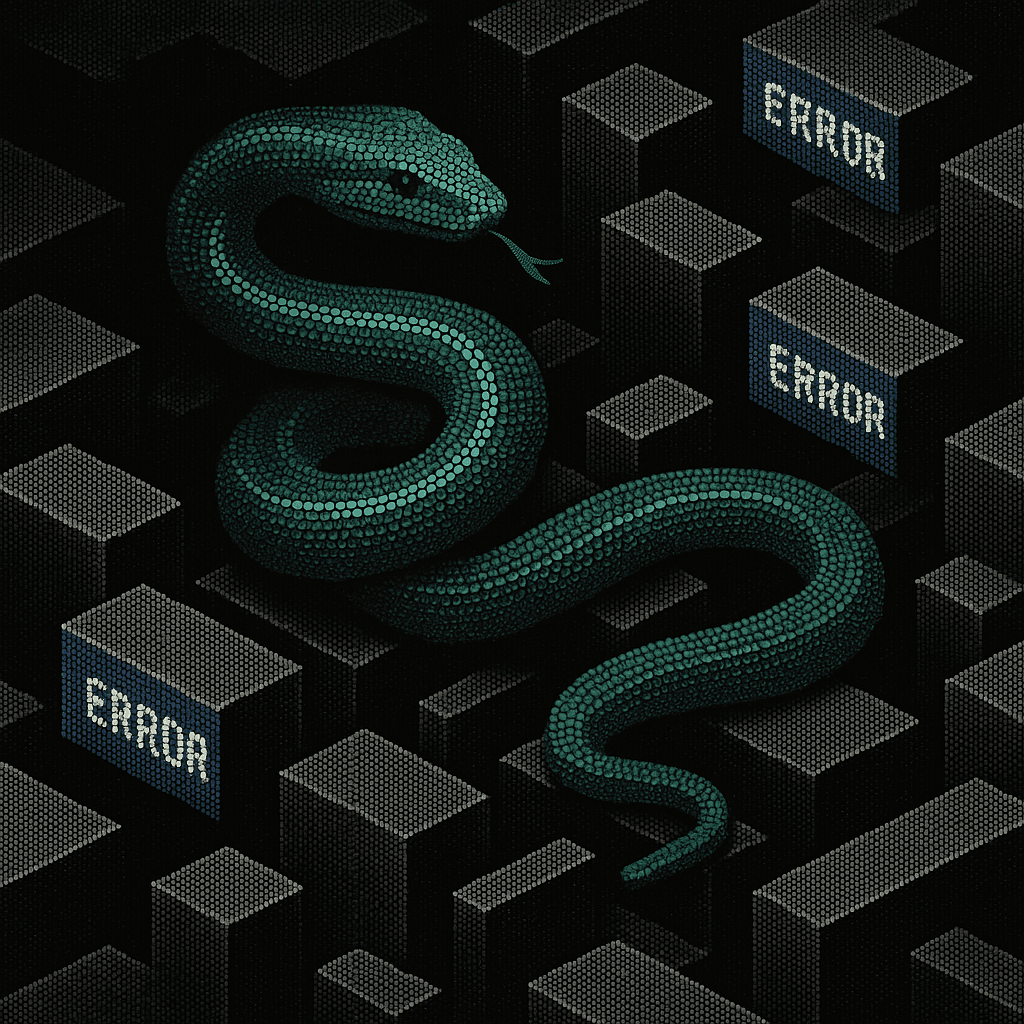
Python Error Handling: 10 Enterprise-Grade Tactics
August 22, 2025
TL;DR
Production Python systems fail predictably: database timeouts masquerade as user errors, concurrent tasks crash silently, and broad exception catches eliminate debugging signals. This guide provides 10 enterprise-grade tactics that transform error handling from reactive firefighting into proactive system design. You'll learn to build precise exception taxonomies, implement structured logging with OpenTelemetry correlation, and leverage Python 3.12+ features like add_note() and enhanced ExceptionGroup handling with except* syntax. These patterns help engineering teams reduce MTTR by 50%+ through structured concurrency with TaskGroup, and align with the 4x ROI that organizations report from comprehensive observability investments.
You push code on Friday at 5 PM. Everything looks green. Your phone starts buzzing at 2 AM Saturday.
Here's what nobody tells you about Python error handling: the code that works perfectly in your local environment can become a debugging nightmare in production. That simple try/except block you wrote? It just masked a database timeout and made it look like user error.
Most developers think error handling means catching exceptions. But there's a world of difference between catching exceptions and handling them well. Production systems that achieve 79% less downtime share a common pattern: they treat error handling as a signal processing system, not just crash prevention.
Build a Precise Exception Taxonomy
Walk into any Python codebase and you'll find this pattern everywhere:
try: charge_card(order)except Exception as err: logger.error("Payment failed: %s", err) raiseThis code is polite. It logs something. It doesn't crash the whole system. It's also completely useless when you're trying to debug why payments are failing.
When everything gets caught as Exception, every failure looks identical. A declined credit card becomes indistinguishable from a network timeout. Your monitoring shows "errors" but tells you nothing about what's actually wrong.
Better approach:
class PaymentError(Exception): passclass CardDeclinedError(PaymentError): passclass FraudSuspectedError(PaymentError): passclass PaymentGatewayTimeout(PaymentError): pass
try: charge_card(order)except CardDeclinedError as err: metrics.increment("payments.declined") raiseexcept FraudSuspectedError as err: trigger_manual_review(order) raiseexcept PaymentGatewayTimeout as err: retry_queue.add(order, delay=300) raiseNow your monitoring tells a story. Card declines get routed to customer support. Fraud alerts go to the risk team. Gateway timeouts trigger automatic retries.
Leverage Context-Rich Structured Logging with Python 3.12+
Raw stack traces tell you something broke. They rarely tell you why it matters or what to do about it.
Python 3.12 introduced the add_note() method for enriching exceptions with contextual information:
def charge(card_id: str, amount: int, user_id: str): try: gateway.charge(card_id, amount) except gateway.CardDeclined as exc: exc.add_note(f"user_id={user_id}") exc.add_note(f"amount_cents={amount}") exc.add_note(f"card_last_four={card_id[-4:]}") exc.add_note("Remediation: ask customer to update payment method") raise
The notes travel with the exception through your entire stack. Combine this with structured logging for maximum debugging power:
import structlogfrom uuid import uuid4
logger = structlog.get_logger()
def handle_checkout(cart, user_id): request_id = str(uuid4()) try: charge_card(cart.total, user_id) except PaymentError as exc: logger.error( "payment_failed", exc_info=True, request_id=request_id, user_id=user_id, amount=cart.total, error_code=getattr(exc, 'code', None), notes=getattr(exc, '__notes__', []) ) raiseCentralize Error Translation with Middleware Layers
When your database connection drops, you don't want every function catching ConnectionError differently. Middleware layers solve this by catching infrastructure problems at the boundary:
from fastapi import FastAPI, Requestfrom fastapi.responses import JSONResponseimport asyncpg
class DatabaseUnavailable(RuntimeError): """Raised when the primary database cannot be reached."""
app = FastAPI()
@app.middleware("http")async def error_translation(request: Request, call_next): try: return await call_next(request) except (asyncpg.PostgresError, ConnectionError) as e: raise DatabaseUnavailable("primary database unreachable") from eNow your business logic deals with DatabaseUnavailable, not the dozen different ways PostgreSQL can fail:
@app.exception_handler(DatabaseUnavailable)async def db_unavailable_handler(request: Request, exc: DatabaseUnavailable): return JSONResponse( status_code=503, content={"error": "Service temporarily unavailable"} )
Implement Resilient Async Error Handling with TaskGroup
Python 3.11+ introduced asyncio.TaskGroup and ExceptionGroup to solve a critical problem: when multiple concurrent operations fail, you see only the first exception while others vanish into the async void.
import asyncio
async def fetch_all_data(urls): try: async with asyncio.TaskGroup() as tg: tasks = [tg.create_task(fetch(url)) for url in urls] return [task.result() for task in tasks] except* TimeoutError as eg: for exc in eg.exceptions: logger.warning(f"Timeout fetching data: {exc}") raise except* ValueError as eg: for exc in eg.exceptions: logger.error(f"Data validation failed: {exc}") raiseThe except* syntax lets you handle different exception types from the same ExceptionGroup. Critical anti-pattern to avoid:
# WRONG - breaks cancellation propagationtry: await some_operation()except asyncio.CancelledError: cleanup() # Missing: raise - this breaks graceful shutdown
# CORRECTtry: await some_operation()except asyncio.CancelledError: cleanup() raise # Always re-raise CancelledError
Enforce Cleanup with Context Managers
Long-running services die a slow death when resources leak. Context managers move cleanup discipline into reusable components:
import timefrom contextlib import contextmanager
class ManagedConnection: def __enter__(self): self.conn = pool.acquire() self.start = time.perf_counter() return self.conn
def __exit__(self, exc_type, exc, tb): duration = time.perf_counter() - self.start METRICS.timing("db_connection_seconds", duration) pool.release(self.conn) return False
with ManagedConnection() as conn: run_query(conn)
Python 3.14 introduces enhanced finally block safety. The new PEP 765 prevents dangerous patterns where control flow statements silently suppress exceptions:
# Python 3.14 warns about this dangerous patterndef risky_function(): try: raise ValueError("Something went wrong") finally: return "Success" # SyntaxWarning in Python 3.14 - exception is swallowed!
Guard Critical Paths with Enhanced Validation
Data corruption bugs don't announce themselves with clean stack traces. Pydantic v2 provides 5-50x faster validation with enhanced error reporting:
from pydantic import BaseModel, ValidationError, conint
class TransferRequest(BaseModel): account_id: str amount: conint(gt=0)
class Config: str_strip_whitespace = True
def transfer_funds(payload: dict) -> None: try: req = TransferRequest(**payload) except ValidationError as exc: exc.add_note(f"raw_payload={payload!r}") exc.add_note("Validation failed at service boundary") raise
debit_account(req.account_id, req.amount)Stream Real-Time Alerts with OpenTelemetry
Raw logs don't scale. OpenTelemetry enables correlation across traces, metrics, and logs:
from opentelemetry import trace, metricsfrom opentelemetry.trace import Status, StatusCode
tracer = trace.get_tracer(__name__)meter = metrics.get_meter(__name__)error_counter = meter.create_counter("app.errors")
def record_error(exc: Exception) -> None: current_span = trace.get_current_span() trace_id = current_span.get_span_context().trace_id
error_counter.add(1, { "error.type": exc.__class__.__name__, "service.name": "payment-processor" })
current_span.record_exception(exc) current_span.set_status(Status(StatusCode.ERROR, str(exc)))
logger.error( "operation_failed", exc_info=True, trace_id=format(trace_id, '032x'), error_type=exc.__class__.__name__ )According to the New Relic 2024 Observability Forecast, organizations with unified telemetry systems achieve 77% faster detection and 77% fewer outages.
Implement Circuit Breakers with State Persistence
Nothing kills a busy service faster than a retry storm. PyBreaker provides production-ready circuit breaking with Redis state sharing:
import pybreakerimport redis
redis_client = redis.StrictRedis(host='localhost', port=6379, db=0)
breaker = pybreaker.CircuitBreaker( fail_max=5, reset_timeout=60, state_storage=redis_client)
@breakerdef call_payment_gateway(payload): response = requests.post( "https://gateway.com/charge", json=payload, timeout=10 ) response.raise_for_status() return response.json()The Redis state storage ensures all service instances share circuit breaker state. Circuit breaker states:
- CLOSED: Normal operation
- OPEN: After failure threshold, requests fail immediately
- HALF_OPEN: After timeout, allows trial requests
Leverage Modern Linting for Error Pattern Detection
Ruff (version 0.14.3) has emerged as the fastest Python linter, implementing 800+ rules including comprehensive error handling checks:
[tool.ruff.lint]select = [ "E", # pycodestyle errors "F", # pyflakes (exception handling) "B", # flake8-bugbear (enhanced patterns) "TRY", # tryceratops (exception best practices) "PLR1708" # stop-iteration-return detection]
# Specific error handling rulesextend-select = ["F707", "B902", "TRY002", "TRY003"]
Key rules that prevent production issues:
- F707: Misplaced bare except clauses
- TRY002: Avoid raising vanilla exceptions
- TRY003: Avoid long exception messages
- PLR1708: Detect dangerous stop-iteration-return patterns
Ruff's auto-fix capability (ruff check --fix) automatically resolves many error handling anti-patterns during development.
Automate Continuous Learning from Incidents
Every production failure teaches you something about where your Python code breaks. The most effective teams encode these lessons directly into their development process:
# pyproject.toml - encode lessons learned
[tool.ruff.lint.flake8-raise]# After incident: bare raise outside except clauserequire-match-for-raise = true
[tool.mypy]# After incident: accessing optional values without checksstrict_optional = truewarn_no_return = true
[tool.pytest.ini_options]# After incident: missing exception path coverageaddopts = "--cov-fail-under=95 --cov-branch"
One payment processing team tagged each postmortem with corresponding lint rules and test fixtures. Critical bug regressions dropped by over 30% over six months.
Why This Actually Matters
These ten tactics form a comprehensive defense system. Each addresses a specific failure mode that impacts teams at scale. Together they create resilience that follows five core layers: retries with exponential backoff, circuit breakers, timeouts, fallback mechanisms, and bulkheads.
The counterintuitive insight most teams miss: good error handling isn't about preventing all failures. It's about making failures debuggable, recoverable, and educational.
According to the New Relic 2024 Observability Forecast, organizations implementing full-stack observability achieve 79% less downtime and 4x ROI on their monitoring investments. The companies shipping reliable Python code figured out something important: catching every possible exception creates systems that fail silently. Better to fail fast with clear signals than limp along with problems you can't diagnose.
When your error handling tells you exactly what broke, where it broke, and what to do about it, you've moved from reactive firefighting to proactive system design. The goal isn't perfect uptime - it's turning every failure into information that makes the next failure less likely or easier to resolve.
Related

Molisha Shah
GTM and Customer Champion